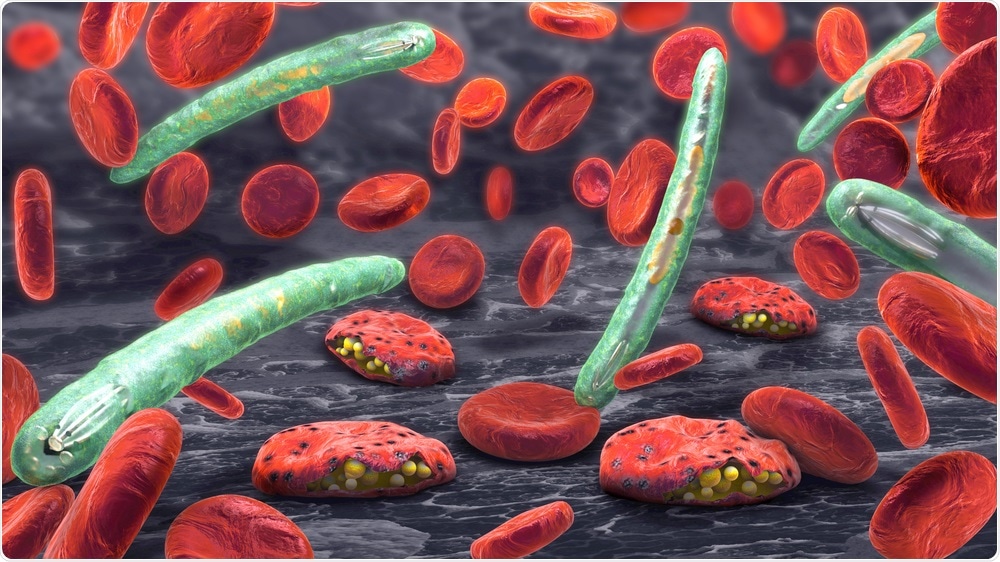An international consortium led by researchers in Sweden and Switzerland has conducted a genome-wide study that the team is calling a “medical breakthrough” in malaria research.

Image Credit: Christoph Burgstedt/Shutterstock.com
The researchers have identified metabolic genes essential to the development of the malaria parasite Plasmodium that could be targeted with new drugs or vaccines for malaria control.
Challenges faced in malaria research
Despite great efforts, attention, and funding in medicine and science, malaria remains a major public health threat, still killing around half a million people globally every year. Furthermore, the pathogen’s combined resistance to drugs and insecticides is slowing progress in developing approaches to combat this deadly disease.
Malaria is transmitted when a Plasmodium-infected mosquito bites a host and injects millions of sporozoites (the spore-like stage of the parasite’s life cycle) into the bloodstream. A proportion of these sporozoites reach the liver, where they invade hepatocytes, increase in size and eventually produce thousands of daughter merozoites. This massive expansion in population requires the parasite to be highly active metabolically.
Plasmodium gene functions in mosquito and liver stages remain poorly characterized due to limitations in the throughput of phenotyping at these stages,”
Volker Heussler, University of Bern
What did this new study involve?
The parasite’s genome is relatively small, only consisting of around 5,000 genes and, unlike human cells, the parasite’s cells only possess one copy of each of those genes. This means that removing one gene from the parasite’s genome would lead directly to a change in phenotype.
Now, in a genome-wide deletion study led by Heussler and Oliver Billker from the Umeå University in Sweden (formerly at the Sanger Institute in the UK,) researchers have removed 1300 individual genes from the parasite and observed the effects across its entire life cycle.
In a mouse model of malaria developed at Bern’s Institute of Cell Biology (ICB), the researchers replaced each of the deleted genes with an individual genetic code, enabling them to monitor the effects of removing each gene among a large population of parasites simultaneously.
After three years of research, the team managed to systematically screen the parasite’s genome throughout all the stages of its life cycle.
Rebecca Stanway from the ICB, says: “The deletion screen carried out jointly with the Sanger Institute enabled us to identify hundreds of targets, particularly in the parasite’s metabolism.”
To analyze many metabolic genes identified, the Bern researchers teamed up with Vassily Hatzimanikatis from the Ecole polytechnique fédérale de Lausanne (EPFL) and Dominique Soldati-Favre from the University of Geneva to form the “MalarX” consortium.
The EPFL group used data from the malaria genome deletion study, to create models that revealed metabolic pathways essential to the parasite’s development.
Predicting unexplored genes that are suitable targets for malaria control
“Thanks to these models, it is now possible to predict which of the previously unexplored genes are vital for the parasite and are therefore suitable targets for malaria control,” says model expert Anush Chiappino-Pepe from the EPFL.
Working in close collaboration with Chris Janse at the University of Leiden, the Netherlands, the Bern researchers were able to confirm some of the models’ predictions.
Bern researcher Magali Roques says the genome-wide screen with the corresponding metabolic models represents “a breakthrough in malaria research.”
Former Sanger Institute scientist Ellen Bushel, says: “Our results will support many malaria researchers worldwide. They can now concentrate on essential parasite genes and thus develop efficient drugs and vaccines against various stages of the parasite’s life.”
Excellent infrastructure and collaboration at an international level led to success
Heussler says the approach taken in this research was only made possible by a combination of the enormous sequencing and cloning capacities at the Sanger Institute and the extraordinary infrastructure at the ICB in Bern, where the entire life cycle of the malaria parasite has been established.
The ICB is also home to an outstanding range of high-performance microscopes that enable top-quality studies into all the stages of Plasmodium’s life cycle.
Commenting on the international collaboration, which involved the contribution of 22 scientists from various fields including parasitology, molecular biology, mathematical modeling and statistics, Heussler says: “This illustrates the effort in conducting this study, analyzing the data and model the experimental findings to bring them in a meaningful context.”
“The combined experimental and computational analysis of pre-erythrocytic development and liver-stage metabolism has led us to identify seven additional metabolic subsystems that become essential compared with the blood stage, which provides a rational basis for the future design of antimalarial therapies targeting metabolic proteins,” concludes the team.
Journal reference:
Stanway et. al., 2019, Genome-Scale Identification of Essential Metabolic Processes for Targeting the Plasmodium Liver Stage, Cell, DOI: https://doi.org/10.1016/j.cell.2019.10.030